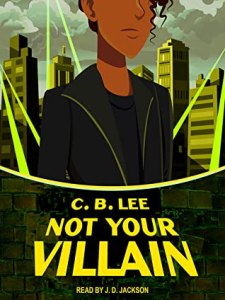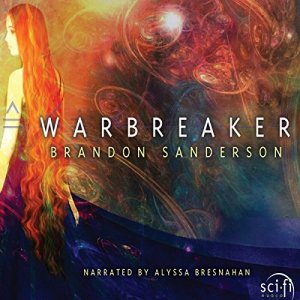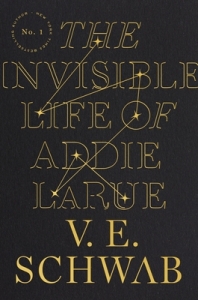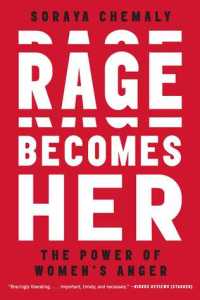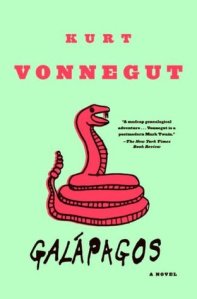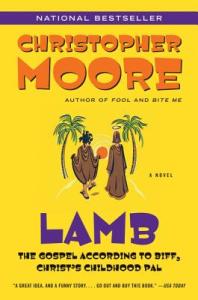Title: Warbreaker
Author: Brandon Sanderson
Genre: Fantasy
Trigger Warnings: Blood, death, body horror, forced marriage, violence, death of children (mentions), religious bigotry
Note: Trigger warnings in DNF books only cover the part I read. There may be triggers further in the book that I did not encounter.
Read To: 56%
Back Cover:
Warbreaker is the story of two sisters who happen to be princesses, the God King one of them has to marry, the lesser god who doesn’t like his job, and the immortal who’s still trying to undo the mistakes he made hundreds of years ago. Their world is one in which those who die in glory return as gods to live confined to a pantheon in Hallandren’s capital city and where a power known as BioChromatic magic is based on an essence known as breath that can be collected only one unit at a time from individual people.
By using breath and drawing upon the color in everyday objects, all manner of miracles and mischief can be accomplished. It will take considerable quantities of each to resolve all the challenges facing Vivenna and Siri, princesses of Idris; Susebron, the God King; Lightsong, reluctant god of bravery; and mysterious Vasher, the Warbreaker.
Review:
I read this book in 2016 according to my list of read books. I had vague recollections of gods in mansions or something and nothing else, but I remember liking it. And a friend had given me a huge collection of Brandon Sanderson audiobooks, all of which are long, and I was working overtime and figured a 24-hour audiobook would be a good way to get through a 50-hour workweek.
I didn’t really want to DNF this one. There are a lot of good things here, and I generally like Brandon Sanderson’s works. I put it down for a day, read something else, and did actually come back to it, but I didn’t find myself wanting to finish it. I didn’t want to DNF it but I didn’t want to keep reading either.
There are three main perspectives in this book. There’s Siri, youngest daughter of the rightful king in exile in the north, sent to marry the god-king of the enemy; Vivenna, the oldest daughter of the rightful king who desperately wants to save her sister; and Lightsong, one of the “gods,” people who returned from the dead with the gift of prophecy, who really wants to convince everyone that he’s not a god at all. There are also a few pages here and there from the perspective of Vasher, a mysterious man with a lot of magic and a sentient sword. Each of these characters has distinct aims, side characters, and situations, and I’m going to tackle each of their storylines individually.
Siri: The classic “independent headstrong princess forced into dangerous new political situation and adapts better than expected.” Not a bad character in and of herself, but her situation (being trapped in the palace and kept from a lot of information or other people) made her parts a bit boring, even though it was through no fault of her own. She did learn a lot about the god-king, though, which kept me interested enough.
Lightsong: He’s a loveable asshole kind of character. He’s a dick and takes nothing seriously, but he’s funny and self-depricating in a way that made me like him anyway. His parts were some of the most politics-heavy (more on that in a minute) but they were still my favorite of the three, which is a testament to how much I liked him as a character.
Vivenna: Highly unlikeable as a character. She’s full of religious prejudice and idealistic patriotism and self-aggrandizing righteousness while believing she’s simple and humble. A short list of things she can’t seem to wrap her head around includes people preferring keeping their children alive over upholding some vague patriotic ideal, people preferring degrading or immortal jobs over starving to death, and people having different religious ideas than her but not being sad about it. It would be one thing if she started out that way and then living in the “heathen city” helped her change, but she resists understanding, acceptance, and change every step of the way. She is sure she’s 100% right about everything and is completely baffled when no one else likes it when she sets them straight. The mercenaries that worked with her were pretty awesome, but her stodgy self-righteousness overshadowed all the good things in her sections. She also got the most page time.
Vasher: This is the guy I wanted to see more of! The story opened on him breaking out of prison and I thought, here’s my epic magical Brandon Sanderson protagonist! And he has a sentient sword, this ought to be good! I had no idea what Vasher’s goals and motivations were but I wanted to find out. But I didn’t. He got hardly any page time and his main purpose seemed to be “ooh, there’s a creepy mysterious bad guy in the background! He’s not doing a whole lot but you should be scared because he’s there!” And honestly, he and his talking sword deserved more.
I’ve made no secret in my reviews that I am not generally a fan of books about politics. Political machinations are just not interesting to me. So I really struggled with the fact that there is a really cool magic system in this book and yet 90% of the plot is about politics. The god-king’s country is probably going to attack Siri and Vivenna’s homeland. Siri was married to the god-king to try and delay that. Vivenna is attempting to thwart the country’s war efforts and “help her countrymen” who live in the capital. And Lightsong is reluctantly getting involved with political machinations among the gods. Magic exists, but the only time it’s used for anything besides causing political problems or Vivenna’s moral crises is when Vasher is on the page.
I love the ideas here. What Siri finds out about the god-king is fascinating, Vivenna could have had an interesting character arc, I actually enjoyed Lightsong as a character, and the magic system is fantastic and complex without being confusing. There are a lot of really great things in this book that I think I could have loved in a story with less of an emphasis on politics and either less of Vivenna’s perspective or a less hateable version of Vivenna. I might come back to this eventually – after all, I’m pretty sure I liked it the first time around. But right now it’s just not doing it for me.

